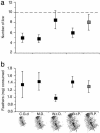Host defense reinforces host-parasite cospeciation
- PMID: 14673114
- PMCID: PMC307630
- DOI: 10.1073/pnas.2533751100
Host defense reinforces host-parasite cospeciation
Abstract
Cospeciation occurs when interacting groups, such as hosts and parasites, speciate in tandem, generating congruent phylogenies. Cospeciation can be a neutral process in which parasites speciate merely because they are isolated on diverging host islands. Adaptive evolution may also play a role, but this has seldom been tested. We explored the adaptive basis of cospeciation by using a model system consisting of feather lice (Columbicola) and their pigeon and dove hosts (Columbiformes). We reconstructed phylogenies for both groups by using nuclear and mitochondrial DNA sequences. Both phylogenies were well resolved and well supported. Comparing these phylogenies revealed significant cospeciation and correlated evolution of host and parasite body size. The match in body size suggested that adaptive constraints limit the range of hosts lice can use. We tested this hypothesis by transferring lice among hosts of different sizes to simulate host switches. The results of these experiments showed that lice cannot establish viable populations on novel hosts that differ in size from the native host. To determine why size matters, we measured three components of louse fitness: attachment, feeding, and escape from host defense (preening). Lice could remain attached to, and feed on, hosts varying in size by an order of magnitude. However, they could not escape from preening on novel hosts that differed in size from the native host. Overall, our results suggest that host defense reinforces cospeciation in birds and feather lice by preventing lice from switching between hosts of different sizes.
Figures





References
-
- Moran, N. A. & Baumann, P. (1994) Trends Ecol. Evol. 9, 15–20. - PubMed
-
- Becerra, J. X. (1997) Science 276, 253–256. - PubMed
-
- Kirk, W. D. J. (1991) Ecol. Entomol. 16, 351–359.
-
- Timms, R. & Read, A. F. (1999) Trends Ecol. Evol. 14, 333–334. - PubMed
-
- Poulin, R. (1998) Evolutionary Ecology of Parasites (Chapman & Hall, London).
Publication types
MeSH terms
Associated data
- Actions
- Actions
- Actions
- Actions
- Actions
- Actions
- Actions
- Actions
- Actions
- Actions
- Actions
- Actions
- Actions
- Actions
- Actions
- Actions
- Actions
- Actions
- Actions
- Actions
- Actions
- Actions
- Actions
- Actions
- Actions
- Actions
- Actions
- Actions
- Actions
- Actions
- Actions
- Actions
- Actions
- Actions
- Actions
- Actions
- Actions
- Actions
- Actions
- Actions
- Actions
- Actions
- Actions
- Actions
- Actions
- Actions
- Actions
- Actions
- Actions
- Actions
- Actions
- Actions
- Actions
- Actions
- Actions
- Actions
- Actions
- Actions
- Actions
- Actions
- Actions
- Actions
- Actions
- Actions
- Actions
- Actions
- Actions
- Actions
- Actions
- Actions
- Actions
- Actions
- Actions
- Actions
- Actions
- Actions
- Actions
- Actions
- Actions
- Actions
- Actions
- Actions
- Actions
- Actions
- Actions
- Actions
- Actions
- Actions
- Actions
- Actions
- Actions
- Actions
- Actions
- Actions
LinkOut - more resources
Full Text Sources

